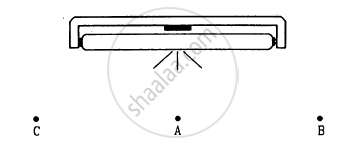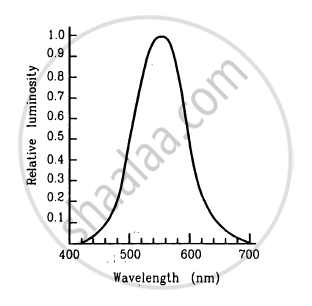Advertisements
Advertisements
प्रश्न
A photographic plate placed a distance of 5 cm from a weak point source is exposed for 3 s. If the plate is kept at a distance of 10 cm from the source, the time needed for the same exposure is _____________ .
पर्याय
3s
12s
24s
48s
उत्तर
12s
Here,
\[d_1 = 5 cm = 0 . 05 m\]
\[ d_2 = 10 cm = 0 . 1 m\]
\[ t_1 = 3 s\]
\[ t_2 = ?\]
Let the actual incident illuminance be \[E_o\]
Let the iluminance at 3cm distance be \[E_{d1}\]
Let the iluminance at 10cm distance be \[E_{d2} \]
\[\cos\theta = 1\]
\[ E_{d1} = \frac{E_o}{{d_1}^2}\]
Now,
\[ t_1 \alpha\frac{1}{E_{d1}}\]
\[ \Rightarrow t_1 = \frac{k}{E_{d1}}\]
\[ \Rightarrow t_1 = \frac{k 5^2}{E_o}\]
\[ \Rightarrow \frac{k}{E_o} = \frac{3}{25}\]
Similarly,
\[ \Rightarrow t_2 = \frac{k {10}^2}{E_o}\]
\[ \Rightarrow t_2 = \frac{3}{25} \times {10}^2 = 12 s\]
APPEARS IN
संबंधित प्रश्न
What is the luminous flux of a source emitting radio waves?
Why is the luminous efficiency small for a filament bulb as compared to a mercury vapour lamp?
Three light sources A, B and C emit equal amount of radiant energy per unit time. The wavelengths emitted by the three source are 450 nm, 555 nm and 700 nm respectively. The brightness sensed by an eye for the sources are XA, XB and XC respectively. Then, ________ .
As the wavelength is increased from violet to red, the luminosity ____________ .
An electric bulb is hanging over a table at a height of 1 m above it. The illuminance on the table directly below the bulb is 40 lux. The illuminance at a point on the table 1 m away from the first point will be about ___________ .
Light from a point source falls on a screen. If the separation between the source and the screen is increased by 1%, the illuminance will decrease (nearly) by ____________ .
Figure shows a glowing mercury tube. The intensities at point A, B and C are related as __________ .

A room is illuminated by an extended source. The illuminance at a particular portion of a wall can be increased by
(a) moving the source
(b) rotating the source
(c) bringing some mirrors in proper positions
(d) changing the colour of the source.
A photographic plate records sufficiently intense lines when it is exposed for 12 s to a source of 10 W. How long should it be exposed to a 12 W source radiating the light of same colour to get equally intense lines?
Using figure, find the relative luminosity of wavelength (a) 480 nm, (b) 520 nm (c) 580 nm and (d) 600 nm.
The relative luminosity of wavelength 600 nm is 0.6. Find the radiant flux of 600 nm needed to produce the same brightness sensation as produced by 120 W of radiant flux at 555 nm.
A source emits light of wavelengths 555 nm and 600 nm. The radiant flux of the 555 nm part is 40 W and of the 600 nm part is 30 W. The relative luminosity at 600 nm is 0.6. Find (a) the total radiant flux, (b) the total luminous flux, (c) the luminous efficiency.
A light source emits monochromatic light of 555 nwavelengthm. The source consumes 100 W of electric power and emits 35 W of radiant flux. Calculate the overall luminous efficiency.
A point source emitting light uniformly in all directions is placed 60 cm above a table-top. The illuminance at a point on the table-top, directly below the source, is 15 lux. Find the illuminance at a point on the table-top 80 cm away from the first point.
An electric lamp and a candle produce equal illuminance at a photometer screen when they are placed at 80 cm and 20 cm from the screen respectively. The lamp is now covered with a thin paper which transmits 49% of the luminous flux. By what distance should the lamp be moved to balance the intensities at the screen again?
Two light sources of intensities 8 cd and 12 cd are placed on the same side of a photometer screen at a distance of 40 cm from it. Where should a 80 cd source be placed to balance the illuminance?
Light rays from a point object ______.
